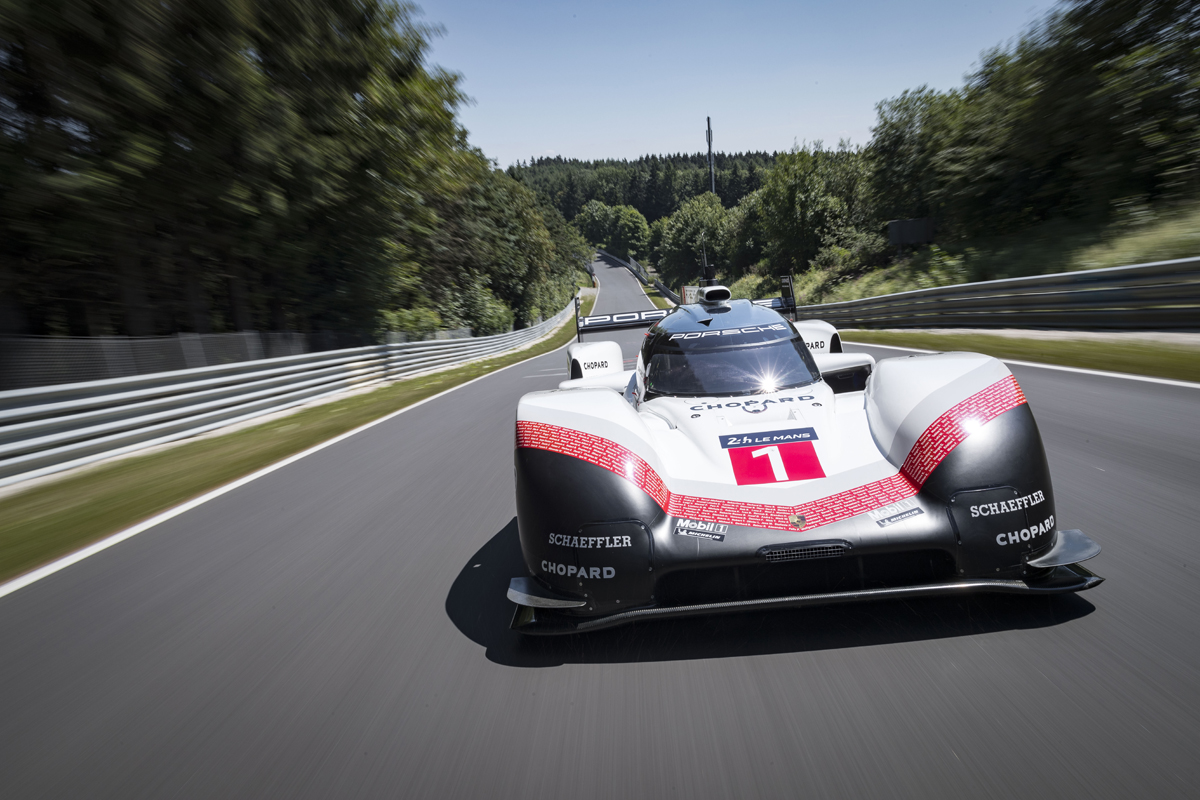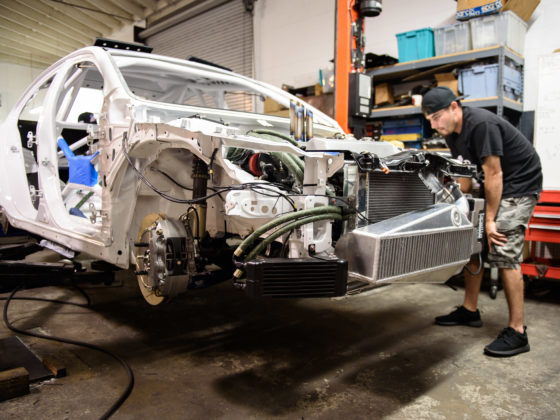Cover image from Porsche Media Gallery
Graphs courtesy of Honeywell Turbo Technologies and from the Honeywell Transportation Systems document, “The Next Generation of Gasoline Turbo Technology”.
You may have heard something about this Porsche 919 Evo. It’s basically a less restricted version of the Porsche 919 that has been racing at Le Mans and in FIA WEC the last few years. Of course, Porsche killed the 919 race program, but still wanted to do something cool with the cars. So, they decided to un-restrict the cars and basically make them time attack cars to break track records. The 919 uses a special turbo that hasn’t been spoken much about and it’s a completely different take on turbos that Honeywell Turbo (we’ll just call it Garrett now because they are changing the name to Garrett Advancing Motion) designed to reduce inertia and improve response. We are here to help explain this technology that has been running in the shadows for the better part of a decade.
First, we need a bit of a history lesson on turbochargers. The evolution in compressor and turbine wheels has been mostly in the area of material selections. Compressors went from aluminum to forged aluminum and titanium to improve strength, temperature capability, and fatigue life. Turbine wheels have gone through various material trials with the goals of improved temperature capability and reduced mass; mass is an important variable affecting transient response of a turbo. The mainstay materials for turbine wheels are Inconel and MarM; the challenge of these two materials are their densities. They are both relatively heavy which is not optimal for transient response. Two other materials have been used for turbine wheels with the goals of significantly reducing mass to improve transient response: ceramic and titanium aluminide (TiAl).
 Garrett used ceramic turbine wheels back in the 1990s on a few applications with diverse sizing from small to big turbos. They were very light and provided superior transient response compared to their metal cousins. Drivers loved the transient response advantage. So what happened to ceramic turbine wheels? Ceramic is extremely brittle which also means they have very low ductility. Because of these material properties, they were very susceptible to foreign object damage (FOD). With a standard Inconel or MarM turbine wheel, any FOD that went through the turbine wheel would just ding a blade and maybe bend it a little. With a ceramic wheel, it would cause the turbine blade to shatter resulting in a failed turbo. Ceramic turbine wheels were used by some OEMs for a short period of time, but they were prone to failure and consequently are not used anymore.
Garrett used ceramic turbine wheels back in the 1990s on a few applications with diverse sizing from small to big turbos. They were very light and provided superior transient response compared to their metal cousins. Drivers loved the transient response advantage. So what happened to ceramic turbine wheels? Ceramic is extremely brittle which also means they have very low ductility. Because of these material properties, they were very susceptible to foreign object damage (FOD). With a standard Inconel or MarM turbine wheel, any FOD that went through the turbine wheel would just ding a blade and maybe bend it a little. With a ceramic wheel, it would cause the turbine blade to shatter resulting in a failed turbo. Ceramic turbine wheels were used by some OEMs for a short period of time, but they were prone to failure and consequently are not used anymore.
 Titanium aluminide has a mixed history in automotive turbocharger use. TiAl originated in the aerospace industry to replace high temperature capable nickel based super-alloys (such as Inconel) used for turbine blades in jet engines. TiAl is about half the density of Inconel giving jet turbines significantly improved thrust-to-weight ratio. The low density of TiAl makes it attractive to reduce rotational inertia of the turbocharger turbine wheel to improve transient response. Industry use of TiAl dates back to the 1990s and research suggests the wheels were prone to failure. One potential explanation is TiAl being an intermetallic compound; this made it difficult to weld the TiAl wheel to the turbine wheel shaft which is typically a steel alloy; trying to weld together dissimilar materials is very difficult and usually results in a weak joint. TiAl is also relatively more difficult to cast leading to possible issues such as porosity that can lead to failures. Lastly, TiAl is very expensive limiting its use. TiAl has been tried in a handful of OEM cars with the only current one I’m aware of being the Ferrari 488.
Titanium aluminide has a mixed history in automotive turbocharger use. TiAl originated in the aerospace industry to replace high temperature capable nickel based super-alloys (such as Inconel) used for turbine blades in jet engines. TiAl is about half the density of Inconel giving jet turbines significantly improved thrust-to-weight ratio. The low density of TiAl makes it attractive to reduce rotational inertia of the turbocharger turbine wheel to improve transient response. Industry use of TiAl dates back to the 1990s and research suggests the wheels were prone to failure. One potential explanation is TiAl being an intermetallic compound; this made it difficult to weld the TiAl wheel to the turbine wheel shaft which is typically a steel alloy; trying to weld together dissimilar materials is very difficult and usually results in a weak joint. TiAl is also relatively more difficult to cast leading to possible issues such as porosity that can lead to failures. Lastly, TiAl is very expensive limiting its use. TiAl has been tried in a handful of OEM cars with the only current one I’m aware of being the Ferrari 488.




13 comments
I Googled, Garret dualboost turbos. I found info back to 2011-12 on forums. But if you go to Garrett website there is no Dual boost turbos for sale and we are in 2018.
Why has this technology still not been offered to the general public at least for aftermarket applications?
What’s interesting is this tech is, somewhat, already on the road. The Ford 6.7 diesel uses a turbo that has this technology on the compressor side, but is otherwise conventional with the turbine. It should be no surprise that the 6.7 turbo is from Garrett.
Are these turbos available from Honeywell or garrett?
What about the VNT turbos?
Tarik, in full disclosure, please know that I work for Honeywell Transportation Systems (TS).
Honeywell is the company; Transportation Systems is the business unit making Honeywell turbos for OEM factory applications; and.. for now… Garrett is our aftermarket brand.
I write “for now” because Honeywell announced plans in Oct 2017 to spin TS into a publicly traded, stand-alone company by the end of Q3 this year. We have subsequently announced the intention to return to our roots and rename the new company Garrett once that happens. https://turbo.honeywell.com/whats-new-in-turbo/press-release/honeywell-announces-garrett-as-company-name-for-transportation-systems-business-after-spin-off/
Thanks Mike, so you’re bringing Garrett and TS together?
How’s this affect the availability of these turbos for the aftermarket?
Thank you!
No effect on our available product portfolio in terms of what currently exists. Again, Garrett is not currently a company, it is a brand. Everything behind the scenes that is TS which supports Honeywell and Honeywell Garrett Aftermarket stays in place.
In addition to the marketing change when we move to rebranding everything Garrett after the spin, the company will enjoy independent governance and the ability to be more responsive and agile to meet industry needs. This is the point of the spin, to give the new Garrett the means to respond more quickly and with greater capability to launch desired innovations in both its OEM and Aftermarket turbo businesses, as well as our electric boosting products and automotive software operations.
Mike, sounds great!
1: You said electric boosting products as in plural, does this mean you have electrically assisted turbos besides your electric compressor? Or are you referring to the Electro hydraulic controlled VNT turbos?
2: It’ll be great to see what Garrett is able to do with loosening the leash.
3: Are VNT gasoline turbos currently available for purchase? If so are they available in the 28/35/40 sizes??
I asked motoiq about this tech several years ago. Surprised it’s taken so long for people to talk about it. kinda hate how this tech is kept secret for so long.
When can I buy one?
Mitsubishi was using TiAl turbine wheels in Lancer Evolution RS models from the EVO6 (which came out in 1999) right up to EVOX.
I’m pretty sure the MHI turbo with TiAl turbine wheel was ONLY used on the Evo 6.5 Tommi Makinen Edition (TME) and it was prone to breaking off. In 2012, Porsche had to put a stop order on the Panamera Turbo because the MHI turbos had their TiAl turbine wheels breaking off again.
Tarik, it appears we’ve exhausted the “reply” function. Shoot me a note at michael.stoller@honeywell.com.
Yes! Finally something about dichter.